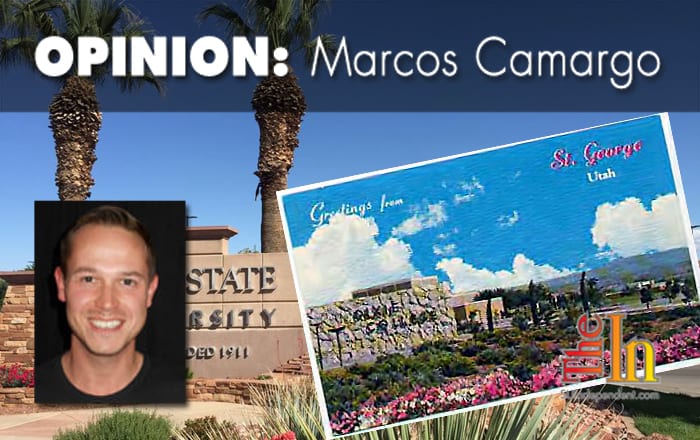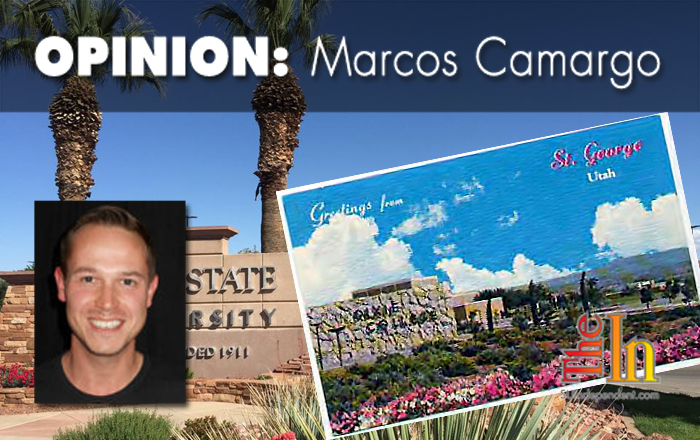 |
| Postcard image: Washington County Historical Society |
Written by Marcos Camargo
Contention rages in Utah’s Dixie over a proposal to change the mascot and name of the local college team. Two reporters from the school paper hash it out. The student in support of the change touts the proposal by writing, “We often have some trouble getting students to come to Dixie” because of the name. The student opposing the change rebuts by asking, “[S]top for a minute and think of the many problems it would involve? There would… be a lot of difficulty in finding a name to please everyone. We are one school, and everything we do, we do together because we are one school. It seems that this would put up a distinct separation.”
The year is 1951. The proposal: that Dixie Junior College changes its mascot from the “Flyers” to the “Rebels.”
Sound familiar?
Or possibly “ironic” would be more appropriate considering the wailing and gnashing of teeth we heard a few years ago from certain local conservative media pundits (who will remain nameless) after university officials decided to abandon the Rebel mascot for the “Red Storm.”
And it sounds just like the past couple of weeks, as we’ve heard many of these same pundits resume their howls.
“Our traditions! Our traditions are at stake!” they cry.
Or as one such propagandist posted on social media: “Will the name of Dixie State University be the next thing forced down the memory hole by the latest Stalinist purge?”
To address said-propagandist, was it the Stalinists who took from us our precious Flyers and gave us Rodney Rebel in 1951? Perhaps it was a distraction from the Korean War? Yes, that must be it, those events happened around the same time, so they must be connected.
Anyway, I digress.
Fast-forward nearly 64 years, and I’m sitting with former Dixie College president and professor emeritus, Dr. Douglas Alder, in his small office off of the Dixie library special collections room. I ask him to tell me a little about the history of Dixie, its name, and its continually changing mascot.
Dr. Alder explained that Dixie has always been Dixie, but that the name’s association has changed several times, the first being the 1951 mascot switch from Flyers to Rebels. Before this time, Dixie was nothing more than a marketing ploy by early settlers to make southern Utah out to be a warm and sunny niche in comparison to the high desert in the northern part of the state.
“[Southern Utah] didn’t have any strong connections to the South,” explained Dr. Alder. “Most of the early settlers came from the Northeast and Midwest. We fought on the side of the North in the Civil War. There were a few settlers, mostly in Washington City, who immigrated from the South and were sent here to grow cotton and run the cotton mill, but that was never very successful.”
He went on to say that he has heard that there are a growing number students and faculty that worry DSU will never grow into a research school if the name “Dixie” (which has ties to both the antebellum and segregationist South) isn’t replaced with something more palatable to outsiders. But he said that regardless of Dixie’s name, DSU will never become a research university anyway.
“There are two public research universities in Utah,” said Dr. Alder. “The first and largest is the University of Utah. The second is Utah State University. Neither of them raises enough funds to support even themselves. Smaller schools like Dixie, SUU and UVU will never become research facilities because the state simply can’t afford it.”
However, according to Dr. Alder, there is probably truth to the argument that the name Dixie could dissuade prospective students outside the region from choosing St George as their destination for higher education.
“For example, a student from Uganda may not want to attend Dixie because of the association with the Old South,” Dr. Alder said.
Dr. Alder also has unique insight into another time the college re-imaged itself. He was the school’s president in 1993 when Dixie finally did away with the Battle Flag of the Confederacy (often called the Confederate Flag) as one of the school’s symbols.
“Back then (when the Confederate Flag was retired) it was a quiet affair,” said Dr. Alder. “No one cared that we got rid of it.”
I spoke with Dr. Alder about all kinds of interesting historical tidbits from this unique part of the Southwest. As he is one of the preeminent Utah historians, I would suggest making it a point to seek out a conversation with this man. You will likely discover something you could never learn from the usual slew of political pundits drowning the airwaves while vying to co-opt history to fit their own ends.
This brings us to my research. Since the latest hubbub over Dixie’s name got fired back up a couple weeks ago, I decided to do a little investigating of my own into the history surrounding the debate. And so I determined the best place to start would be with old Dixie yearbooks, which present the history of the school’s culture not how we want it to be, but how it was.
Until 1952, both Dixie High and Dixie Junior College used the Flyers as their team name and mascot. But in November 1951, in order to further separate the junior college from the high school, the college requested suggestions for a new mascot. One proposal gained popularity above all others: the Rebels; and by January 1952, the college paper had begun referring to the school’s teams by that name. But until the 1956 school year, there is no evidence yet unearthed showing that the school had heavily embraced a southern Utahn Confederate culture.
Even by 1956, the only obvious reference to the South was a caricature of a Confederate soldier holding a gun equipped with a bayonet. Previous to the mascot change, there existed no obvious cultural or traditional connection to the South except for the name Dixie—at least not in anything I could find, but I welcome any evidence that can prove me wrong.
Then in 1960, photos began to emerge showing the Confederate Flag alongside the American Flag in awards ceremonies, including a photo of current LDS apostle, Jeffrey Holland, receiving a Dixie award. The next year, 1961, team uniforms started to display the Confederate Flag in all its treasonous glory.
It seems, however, that the descent into a full embrace of neo-Confederate culture really took off between 1963 and 1966, at which time the yearbook changed names from “The Dixie” to “The Confederate.” On D-Day—a Dixie celebration not to be confused with the western invasion of Nazi occupied Europe—parade floats began vigorously adopting themes from the Old South: black face, Confederate costumes, horseman carrying the Confederate battle standard. You name it, Dixie did it, including mock slave auctions.
It is now time for a conjecture interlude:
Why was it that at the height of the Civil Rights Movement of the 1950s and 1960s Dixie College all of a sudden decided to incorporate Confederate regalia into the school’s “tradition?” Perhaps it was a reaction against a freedom movement that threatened to weaken the perceived axiom of white supremacy that had, until then, remained an unchallenged part of American “tradition.” In other words, ultra-conservative communities like St George harbored deeply ingrained racism.
But “traditions” are always worth preserving, right?
Returning to our history analysis, one can see from yearbook photos that Confederate fervor reached its peak in the mid-1960s to the early-1970s and remained a large part of Dixie State culture until it started to fade out in the 1990s.
That is, until now. Since Dixie State made the move from a state college to a state university, another wave of neo-Confederate traditionalists have emerged.
These ghosts of Confederates past want this community to believe that those of us pushing for Dixie to relinquish antiquated tradition in exchange for a true university are a bunch of godless Communists bent on brainwashing your children and confounding their tongues with newspeak (if you listen to the rhetoric, what I just said does not even qualify as an exaggeration). In fact, all we want is a university that can attract a universally diverse group of students and faculty; a university that can send Dixie alumni off into the far reaches of the world without having to explain why their diploma is stamped with a name associated with slavery and subjugation.
Utah’s Dixie may have started as a tradition of its own. That tradition, however, was effectively smothered by well-documented racism that occurred right here in southern Utah.
But don’t worry Dixie grads, just tell all those future interviewers that’s its only a very important part of your university’s “tradition.” I’m sure they’ll understand.




